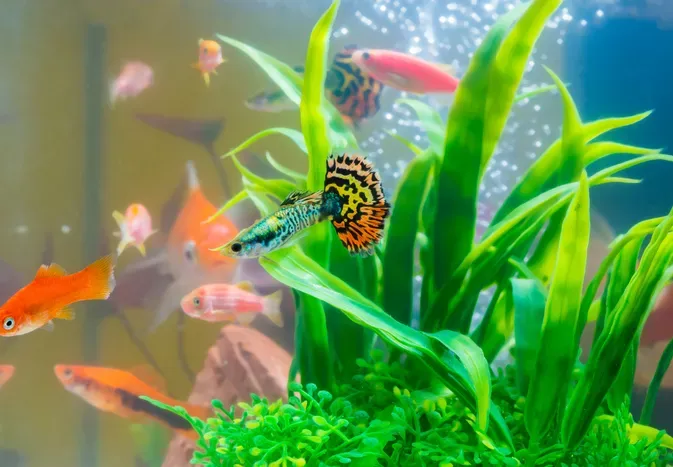What to Know About Aquarium Sump and Overflow Box Setups
Updated on 04/26/24

Discover the Secrets of Aquarium Sump and Overflow Box Setups: An In-Depth Guide
Welcome to our comprehensive blog post, where we delve into the intricacies of aquarium sump and overflow box setups. By the end of this in-depth guide, you'll possess an arsenal of knowledge to optimize your aquatic ecosystem and maintain the well-being of your beloved fish and marine life.
Understanding the Anatomy of a Sump and Overflow Box Setup
To begin, let's familiarize ourselves with the key components of a sump and overflow box system.
The Sump
A sump, often referred to as a wet/dry filter, is a separate tank that sits beneath the main aquarium. It acts as a filtration, circulation, and water storage unit, providing several advantages:
- Enhanced Filtration: Sumps allow for the integration of various filtration media, such as live rock, bio balls, or protein skimmers, resulting in more thorough water purification.
- Reduced Noise: The sump's location beneath the aquarium effectively muffles the noise generated by pumps, skimmers, and other filtration equipment.
- Increased Water Capacity: Sumps provide additional water volume, offering a buffer against water parameter fluctuations and providing a safety net in case of leaks or evaporative losses.
- Aesthetic Appeal: Sumps can be hidden from view, preserving the visual harmony of your aquarium setup.
The Overflow Box
An overflow box, installed within the main aquarium, acts as a gatekeeper, directing excess water into the sump. It consists of two compartments:
- Wet Chamber: The wet chamber houses the standpipe, the main conduit for water flow into the sump.
- Dry Chamber: The dry chamber collects water overflowing from the wet chamber, ensuring that the overflow box remains primed and prevents air from being sucked into the system.
Types of Sump and Overflow Box Configurations
There is a range of sump and overflow box setups tailored to specific aquarium needs. Here are some common types:
- Hang-on-Back (HOB) Sumps: These compact sumps mount on the back of the aquarium, offering a convenient option for smaller setups.
- In-Cabinet Sumps: Designed to fit within the cabinet below the aquarium, these sumps provide more space for filtration components and greater water capacity.
- Remote Sumps: Remote sumps are independent units located in a separate room or area, allowing for maximum flexibility and ample filtration capacity.
- Gravity-Fed Overflow Boxes: Gravity-fed overflow boxes rely on the natural force of gravity to direct water from the aquarium into the sump.
- Siphon-Based Overflow Boxes: Siphon-based overflow boxes use the principles of siphonage to draw water from the aquarium, providing greater flow rates.
Benefits of a Sump and Overflow Box Setup
Implementing a sump and overflow box setup in your aquarium offers numerous advantages:
- Improved Water Quality: Sumps provide a larger surface area for beneficial bacteria to colonize, promoting water purification and nutrient removal.
- Increased Oxygenation: The water flowing through the sump undergoes aeration, enriching the aquarium water with dissolved oxygen essential for aquatic life.
- Enhanced Clarity: Sumps help trap suspended particles and debris, resulting in crystal-clear aquarium water.
- Water Volume Expansion: The additional water volume provided by the sump acts as a buffer against changes in salinity, temperature, and pH levels.
- Equipment Concealment: Sumps allow for the discreet placement of filtration equipment, maintaining the aquarium's aesthetic appeal.
Planning and Installation Considerations
Before embarking on a sump and overflow box installation, meticulous planning and attention to detail are paramount.
Choosing the Right Size
The appropriate sump and overflow box size is crucial. Generally, sumps should have a capacity of approximately 10-15% of the main aquarium's volume. The overflow box should have a flow rate adequate to handle the volume of water produced by your aquarium's pump.
Placement
Carefully consider the placement of the sump and overflow box. Ensure the sump is easily accessible for maintenance and the overflow box is positioned to accommodate the desired water flow.
Plumbing
The plumbing of the sump and overflow box system requires precision and leak-proof connections. Use high-quality pipes, fittings, and valves to guarantee reliability and longevity.
Conclusion
Aquarium sump and overflow box setups are invaluable assets for hobbyists seeking to create a thriving and aesthetically pleasing aquatic environment. By understanding their components, benefits, and installation considerations, you can maximize the potential of your aquarium and provide exceptional care for your cherished marine life. Remember, thorough research and consultation with experienced aquarists are invaluable resources to ensure a successful implementation of your sump and overflow box system.
Explore More Pets

Freshwater Aquarium Filters
How to Deal With Cloudy Aquarium Water

Saltwater Aquarium Filters
How Do You Remove Chloramines From Tap Water?

Freshwater Aquariums & Habitat
Can I Keep My Koi Fish Inside?

Saltwater Aquariums & Habitat
14 Best Floating Plants for Your Aquarium

Freshwater Fish Health
How to Treat Ich on Freshwater Fish

Saltwater Fish Health
Fin Rot in Aquarium Fish

Freshwater Aquarium Filters
How to Do Aquarium Water Changes

Saltwater Fish Health
How Do Fish Get Parasites?